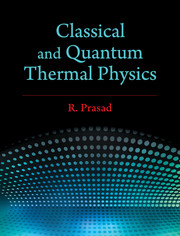Book contents
- Frontmatter
- Dedication
- Contents
- Figures
- Tables
- Preface
- Acknowledgments
- 1 The Kinetic Theory of Gases
- 2 Ideal to a Real Gas, Viscosity, Conductivity and Diffusion
- 3 Thermodynamics: Definitions and the Zeroth Law
- 4 First Law of Thermodynamics and some of its Applications
- 5 Second Law of Thermodynamics and some of its Applications
- 6 Tds Equations and their Applications
- 7 Thermodynamic Functions, Potentials, Maxwell's Equations, the Third Law and Equilibrium
- 8 Some Applications of Thermodynamics to Problems of Physics and Engineering
- 9 Application of Thermodynamics to Chemical Reactions
- 10 Quantum Thermoynamics
- 11 Some Applications of Quantum Thermodynamics
- 12 Introduction to the Thermodynamics of Irreversible Processes
- Index
- Frontmatter
- Dedication
- Contents
- Figures
- Tables
- Preface
- Acknowledgments
- 1 The Kinetic Theory of Gases
- 2 Ideal to a Real Gas, Viscosity, Conductivity and Diffusion
- 3 Thermodynamics: Definitions and the Zeroth Law
- 4 First Law of Thermodynamics and some of its Applications
- 5 Second Law of Thermodynamics and some of its Applications
- 6 Tds Equations and their Applications
- 7 Thermodynamic Functions, Potentials, Maxwell's Equations, the Third Law and Equilibrium
- 8 Some Applications of Thermodynamics to Problems of Physics and Engineering
- 9 Application of Thermodynamics to Chemical Reactions
- 10 Quantum Thermoynamics
- 11 Some Applications of Quantum Thermodynamics
- 12 Introduction to the Thermodynamics of Irreversible Processes
- Index
Summary
The book is designed to serve as a textbook on thermal physics / thermodynamic that may be prescribed to graduate students of physics, chemistry and engineering branches. The book covers all three components of thermal physics: namely the kinetic theory, classical thermodynamics and quantum thermodynamics (quantum statistical mechanics plus thermodynamics), with their applications. Some topics in the book may also be of interest to post graduate students. Since the focus of the book is on 85–90% average and below average students of the class, it is written in simple English with detailed and stepwise derivations starting from first principles. I hope that teachers of the subject and also readers other than the targeted audience, will also like the presentation.
Kinetic theory and transport properties of gases are covered in first two chapters of the book. Maxwell–Boltzmann velocity distribution for an ideal gas, which is mostly derived using the tools of quantum thermodynamics, is obtained in chapter-1 by the method originally used by Maxwell. The four laws of classical thermodynamics and their applications are discussed in chapters 3–8.
A special feature of the book is a separate chapter on the application of classical thermodynamics to chemical reactions (chapter-9), which is generally not covered in books on the subject. Though there are books on the application of thermodynamics to chemical reactions, unfortunately these books do not explain the underlying principles of physics associated with thermodynamics and are, therefore, incomplete. Since chemists use different notations and signs for thermodynamic parameters than those used by physicists and engineers, a separate chapter is included where these differences are clearly mentioned along with their reasons. Each application is explained through an example of an appropriate chemical reaction where technical terms are explained and mathematical derivations are worked out starting from the first principle.
Similarly, engineering applications of classical thermodynamics are discussed in a separate section. These applications are explained with the help of P–V and P–s–h diagrams wherever necessary and are followed by large number of solved and unsolved problems with answers.
Information
- Type
- Chapter
- Information
- Classical and Quantum Thermal Physics , pp. xxi - xxiiPublisher: Cambridge University PressPrint publication year: 2016
